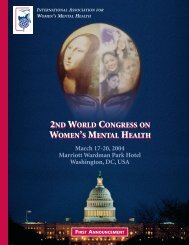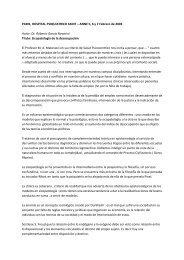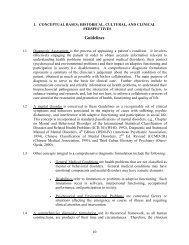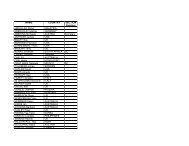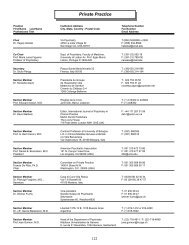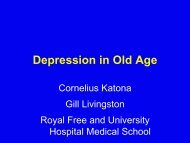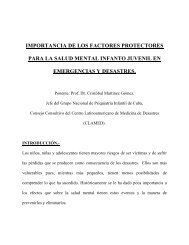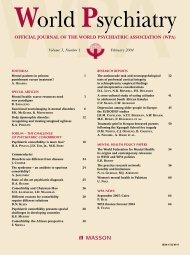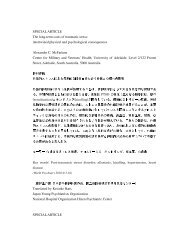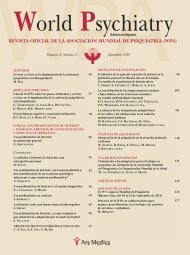ABSTRACTS - World Psychiatric Association
ABSTRACTS - World Psychiatric Association
ABSTRACTS - World Psychiatric Association
Create successful ePaper yourself
Turn your PDF publications into a flip-book with our unique Google optimized e-Paper software.
useful in clinical practice as an adjuvant treatment for hospitalized<br />
patients with severe, drug-resistant major depression.<br />
PO1.166.<br />
VAGUS NERVE STIMULATION AND RESISTANT<br />
DEPRESSION: A SYSTEMATIC REVIEW<br />
C. Daban, A. Martinez-Aran, N. Cruz, M. Bonin, E. Vieta<br />
Clinical Institute of Neurosciences, Hospital Clinic, University<br />
of Barcelona, Spain<br />
Since 2005, vagus nerve stimulation (VNS) is considered as an<br />
adjunctive for treatment-resistant depression (TRD) (unipolar or<br />
bipolar). Our objective is to give a clear overview of the safety and<br />
efficacy of the VNS by means of a systematic review. The review was<br />
made using the major databases beginning in January 2000 until April<br />
2008. A total of 108 references were found, but only 20 add-on studies<br />
meeting the required criteria were selected for this review. Since<br />
only one double-blind randomized study was published, a metaanalysis<br />
was not feasible. Regarding the efficacy, VNS is associated to<br />
a reduction of depressive symptoms in a majority of the open studies.<br />
Unfortunately, in the only double-blind study the results are rather<br />
disappointing and inconclusive. Regarding safety, despite its invasive<br />
nature, VNS can be considered as safe and feasible. VNS therapy is<br />
an interesting new approach for the treatment of TRD. Although the<br />
results are rather promising, we must be cautious in our conclusions<br />
since the evidence is only based on open studies. Further clinical trials<br />
are needed in bipolar patients, regarding the predictors of<br />
response, the cost-efficacy and the mechanism of action to better<br />
understand and develop VNS therapy for affective disorder.<br />
PO1.167.<br />
FUNCTIONAL OUTCOME AFTER 12 MONTHS<br />
OF DEEP BRAIN STIMULATION FOR TREATMENT<br />
RESISTANT MAJOR DEPRESSIVE DISORDER<br />
S.H. Kennedy, S. Rizvi, H. McNeely, P. Giacobbe, H.S. Mayberg,<br />
A.M. Lozano<br />
University of Toronto, Ontario, Canada; St. Joseph’s Hamilton<br />
Healthcare, Hamilton, Canada; McMaster University, Hamilton,<br />
Canada; Emory University, Atlanta, GA, USA<br />
Although improvements in function are fundamental to recovery<br />
from a depressive episode, reductions of individual symptoms often<br />
precede objective increases in a patient’s functional capacity. In order<br />
to assess the full utility of an antidepressant therapy, it is not only necessary<br />
to explore the rate of symptom decline, but also the trajectory<br />
for improvement across various domains of function. In 20 patients<br />
with treatment resistant major depressive disorder, measures of mental,<br />
physical, and sexual function, and neuropsychology tests that<br />
assess executive function, memory and emotional responsivity, were<br />
administered before and at various times up to 12 months after deep<br />
brain stimulation to the subcallosal ingulated gyrus. The rate and<br />
degree of functional improvement across measures was analyzed for<br />
all patients. The influence of executive function, memory and emotional<br />
responsivity and personality dimensions was also examined in<br />
relation to functional outcome. The results extend the emerging evidence<br />
base on deep brain stimulation as an alternative to existing<br />
options for treatment resistant depression.<br />
PO1.168.<br />
APPLYING TWO TRANSCRANIAL MAGNETIC<br />
STIMULATION SESSIONS PER DAY COULD HELP<br />
IN THE FASTER REDUCTION OF DEPRESSIVE<br />
SYMPTOMS<br />
P. Sakkas, C. Theleritis, C. Psarros, V. Masdrakis,<br />
T. Paparrigopoulos, G.N. Papadimitriou<br />
First Psychiatry Department, Athens University Medical School,<br />
Eginition Hospital, Athens, Greece<br />
During the last seven years, we completed various pilot studies using<br />
repetitive transcranial magnetic stimulation (rTMS), trying to evaluate<br />
its efficiency. In this context we selected some patients suffering<br />
from drug resistant major depression, who wanted to be treated with<br />
rTMS, and gave them an intensive treatment. We raised the magnetic<br />
intensity to 110-120% of the motor threshold. We gave them about 40<br />
trains of 20-25 Hz per session, using two electromagnetic coils. Also,<br />
we extended the overall duration of treatment to three weeks.<br />
Patients were evaluated with the Hamilton Depression Rating Scale<br />
(HDRS) at baseline as well as at the end of every week thereafter. In<br />
addition, we extended our period of clinical assessment to two more<br />
weeks, because we had an indication from some of our patients that<br />
rTMS sometimes produces a late effect. Ten patients were treated with<br />
two daily sessions (one in the morning, and another in the afternoon)<br />
for five days every week and for three consecutive weeks. Preliminary<br />
results indicate that patients who were treated with two daily sessions<br />
of rTMS had a faster reduction of depressive symptoms on the HDRS,<br />
and some of them also a faster remission of depressive symptoms, in<br />
comparison to patients treated with one rTMS session per day. Further<br />
investigations in larger patient populations should verify this preliminary<br />
result.<br />
PO1.169.<br />
NON-ECT TREATMENT OF CATATONIA<br />
M. El-Shazly, M. Chandran<br />
Department of Neurosciences, University of Birmingham; Hallam<br />
Street Hospital, Birmingham, UK<br />
Catatonia is considered a rare and potentially lethal condition. It is a<br />
syndrome that encompasses multiple motor signs. It can be the only<br />
presenting feature in a patient with underlying multiple neuropsychiatric<br />
syndrome. It is, however, more usually associated with schizophrenia<br />
and to a lesser extent with mixed manic episodes in bipolars.<br />
Electroconvulsive therapy (ECT) is generally considered the treatment<br />
of choice for various forms of catatonia, e.g., organic, lethal and<br />
schizophrenic. The use of benzodiazepines in catatonia remains unlicensed.<br />
There are reports of the use of intravenous (i.v.) low-dose<br />
lorazepam in treating excited catatonia, while higher doses are reported<br />
to have worsened the condition. We present the treatment of four<br />
different types of catatonia (one of organic/antipsychotic induced,<br />
one of iatrogenic, one of schizophrenic and one of depressive catatonia)<br />
without the resort to ECT or i.v. medication. In all cases benzodiazepines<br />
were used, mostly during the stuporous phase. The use was<br />
judicious and time limited. Other treatment strategies were used such<br />
as withdrawing certain drugs or the introduction of others. All cases<br />
responded satisfactorily. In no case ECT was needed. We discuss these<br />
cases in detail and present a review of the literature on the use of benzodiazepines<br />
in catatonia. We present an argument for including catatonia<br />
as one of the indications for benzodiazepine use.<br />
197



